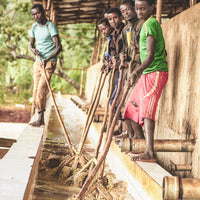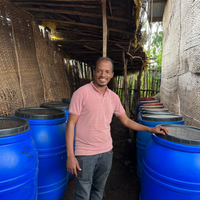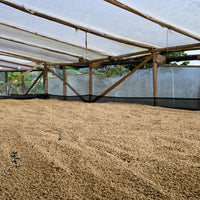Origin: Costa Rica
Region: Alajuela, West Valley
Altitude: 1400 - 1700 meters above sea level
Producer: Alejo Kahle Castro
Variety: SL28
Process: Natural
Tasting Notes: Complex and buttery with notes of blueberry, tropical fruit, black tea and melon.
At the beginning of the 19th century, when coffee production was in its early beginnings in America, without knowing it, two pioneers and entrepreneurs, Alejo C. Jiménez in Costa Rica and Wilhelm Kahle in the south of Mexico, shared the same dream: “To produce the best coffee in the world” to satisfy the new demanding European gourmet market.
Today, descendants of these visionary farmers still produce coffee within the same ideals of excellency and top quality that inspired their ancestors that continue with the tradition in Costa Rica.
Today, the production process starts with the planting of the coffee trees on highly fertile volcanic soil above 1400 meters above sea level (SHB) in 3 different regions from Costa Rica.
Nowadays, the descendants of Don Alejo C. and Don Wilhelm want to further enhance the principles of quality inherited by our founders by adding the value of conservancy of natural resources, through the acquisition of extensions of natural rainforest for its protection and conservation. These facts, not just words, are small actions taken by one family to reduce air contamination and global warming. This is the contribution we want to make to mankind, this is the new awareness we want our future generations to inherit.
Today, the farm is managed by Alejo Khale Castro. His dedication to quality and innovative drive has seen Volcán Azul consistently placing in COE, picking up 2nd spot in 2017, two places in 2020 and another two places in 2021.
This is the part of the process that catches less attention, but it's probably the most important part of processing great quality coffee. It is the most difficult part because it takes constant hard work for years and stopping doing this for a short period will spoil all the work done all the years before.
Pre Harvest - In order to have a well developed coffee bean with complex flavours we need to plant the best varieties, manage the soil so its healthy and able to give the nutrients the tree needs, protect the plantations from diseases and to procure sustainability so we can have constant high quality for many years.
Harvest - Its fundamental that we pick the cherries at optimum level of ripeness This will allow us to have more complex flavors in our cup of coffee We have found that measuring the brix content of the mucilage of the coffee cherries we can know the best time to pick them In our farm we usually start at 22 brix content (depending on the variety but we have had measurements of 28 even 30.
Wet Mill - The first step is to measure the cherries coming from the plantation by truck or tractor. We measure the cherries by volume using a box of 200 liters; 2 of these will give us 1 fanega (400 liters) that will give us around 46kg of green coffee. After this, we separate floaters which normally are unripe, overdried or defective cherries. At this step we also clean the coffee from branches, leaves, dirt, and any other foreign matter that comes from the field.
After this step we must decide which process we are going to give to the lot we have just harvested. It's fundamental to slow dry our coffee to preserve our quality. It's important to understand that the more mucilage, pulp and time, the more fermentation we are going to have in the process while drying our coffee.
Processing Natural - The cherries are taken to the patio or raised beds with all the pulp. Depending on the fermentation we want for the process we can keep the lots unstirred for a period and, we can make thicker or thinner layers while drying. Then the coffee will be stirred each day from 8am to 2pm. At 2pm we start covering the coffee with plastic, so we maintain it warm during the night and it won´t gain humidity from the mist we normally have during the early morning. This process will take between 12 and 16 days depending on the weather.







